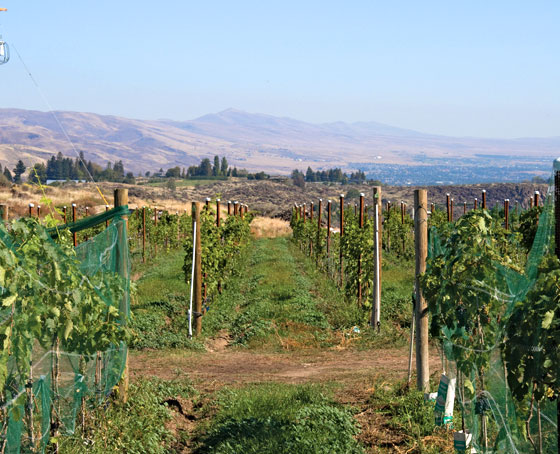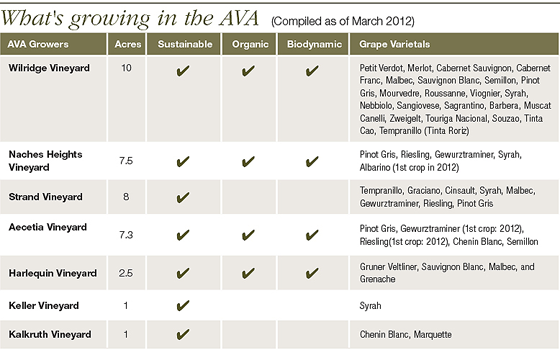A glimpse at Washington State’s newly christened wine growing region, where sustainable farming and outdoor recreation coexist

Published March 2012
You leave your bicycling gloves on the picnic table that commands a view of the vineyard and overlooks the eastern rim of the plateau—and across Upper Yakima Valley. Wise move: choice tables are scarce on this fine spring day. Glancing at your mountain bike reposing on the lawn, you amble to the table with your plate of antipasto and glass of wine, cleats clacking on the wooden porch.
You earned these treats after a long bike cruise through Cowiche Canyon with a tough climb to the plateau, cycling through browning meadows on a trail that wound upwards between fractured knolls of andesite, eventually leading you past a vineyard on your way to The Tasting Room Yakima. Here, barely fifteen minutes northwest of Yakima’s city limits, you slow down and read the vineyard row labels, finding many Bordeaux varietals, some Rhone grapes, too. Even Roussanne. But Zweigelt? Sagrantino?
Now, relaxing in a wooden chair, you survey Wilridge Vineyard while savoring a glass of Nebbiolo. It’s a liquid ruby with youthfully intense blackberry, cherry, and a whiff of violet, framed by surprisingly smooth tannins, sporting hints of leather, anise, and minerals. A fine match for the antipasto.
100% Sustainably Farmed
Your gaze skims over chickens scattered among the grapevines and rests upon the neighboring andesite knoll, formed by a million-year-old lava flow. Like tastebuds, such outcrops dot the tongue of andesite that underlies Naches Heights AVA (American Viticultural Area), effectively subdividing it so that it will always be the domain of small producers.
Paul Beveridge, who owns Wilridge Vineyard, likes these rocky outcrops and bedrocks that embrace the vineyards. “Some of the best vineyards in the world are found on really poor, rocky soils like these,” he says.
Another producer using fruit from the AVA is Phil Cline, who in 2002 planted his Naches Heights Vineyard. He also manages the other six vineyards in the appellation, including that of Robert Goodfriend, the owner of Harlequin Wine Cellars. His small vineyard is planted with five varietals, and the 2012 crop will be the first to get bottled.
Of the appellation’s 37 bearing acres (and more waiting to be planted), all are farmed sustainably. Some, such as Wilridge Vineyard, are farmed biodynamically, which means—among other holistic things—encouraging help from animals. Marmots can’t reach the grapevine canopy, but gnaw unwanted suckers off of the trunks and some weeds, while adding fertilizer. The chickens also add fertilizer. Kestrels, which discourage fruit-eating birds, are given nesting boxes.
Unique Terroir
Starting at 1200 feet and rising to over 2000, Naches Heights is just as sunny as the Columbia Valley AVA, but cooler. This blesses grapes with ripeness balanced by acidity. Wilridge Vineyard is planted to 23 different wine grape varietals and serves as the area’s test plot. It’s a warmer site than Cline’s, but it has cooler spots. Most varietals have done well when planted in an area with an appropriate temperature profile.
“The main thing we’ve proven with these experiments in the five years we’ve been doing it, is that you really can grow just about anything on Naches Heights if you give it the right placement,” says Beveridge.
“What has a lot of attraction is that andesite has a lot of feldspar and quartz in it,” explains Cline. “Quartz is a big component of biodynamic farming, and probably some of it has flaked off into the soil. We use horn silica, which is quartz ground up very finely, in our preps. The silica is there to attract the sun energy.”
The andesite is younger than the basalts of Columbia Valley over which it flowed, while the windblown loam covering the andesite is older than the flood sediments deposited over the Columbia Valley. Both rock and soil are chemically different from those of Columbia Valley, and could well impart a distinctive flavor profile to the AVA’s wines. With only a few vintages made from its fruit, it’s a bit early to define that profile, but Beveridge and Cline offer some general impressions.
Beveridge cites “an intensity of fruit expression. You can really taste the varietal. Nebbiolo tastes like Nebbiolo, Sangiovese tastes like Sangiovese. We’re not so fertile, or so spoiling the grapes, that they start to taste all the same. The wines have great acidity with lots of balanced ripeness.”
“I believe Naches Heights wines display very nice aromatics and great color,” adds Cline. “The tannins are silky.”
Recreational Mecca
On ensuing visits, you might ascend the trail to the vineyard by horseback or on foot. A friend voluntarily installed a hitching post at Wilridge. One will soon be able to hike all the way to Mount Rainier on the William O. Douglas trail. Rough camping is allowed on the property.
Looking for an upper body workout to earn your wine? A small crag of sound andesite sports established climbing routes. You can bust your moves before an admiring gallery of violet green swallows perched on the adjacent fence and hikers in the canyon below.
NHV Tasting Room
A half mile hike from Wilridge is Doug McKinnon’s Aecetia Vineyard, home to NHV’s (Naches Heights Vineyard) tasting room built in 2012. Two imposing tracking solar panels flank the entry, and the vineyard has sprouted a windmill. In the kitchen of the energy-efficient farmhouse, a chef is busy preparing all sorts of gourmet dishes and bites, including flatbreads, charcuterie and cheese platters to appease the most discerning taste buds. Guests can enjoy glasses of wine (even craft beer sold on-site) by a peaceful koi pond fed by a small cascading waterfall. McKinnon and Cline hope to plant more acreage and will soon offer glamorous forms of camping (“glamping”) on the beautifully landscaped grounds.
Recreational Mecca
On ensuing visits, you might ascend the trail to the vineyard by horseback or on foot. A friend voluntarily installed a hitching post at Wilridge. One will soon be able to hike all the way to Mount Rainier on the William O. Douglas trail. Rough camping is allowed on the property.
Looking for an upper body workout to earn your wine? A small crag of sound andesite sports established climbing routes. You can bust your moves before an admiring gallery of violet green swallows perched on the adjacent fence and hikers in the canyon below.
“If we can keep getting people to go organic, or even biodynamic, I think that would be nice,” says Beveridge.
You latch your bikes to the roof racks, savoring the last hint of the Nebbiolo and thinking about your next visit. Next time, you’ll pair the Barbera with your climbing gear.
More information about the AVA:
Sustainable, Organic, or Biodynamic?
A unique aspect of the Naches Heights AVA is that all of the vineyards are currently sustainably farmed by some combination of the following practices. Here’s a quick primer on the basic growing terms:
Sustainable: A lot like traditional farming, this means the grapes are farmed with the least possible intervention, both mechanically and chemically.
Organic: You can rest assured no synthetic herbicides, pesticides, fungicides, or fertilizers have been used on the grapes. Certification by USDA.
Biodynamic: Organic and holistic, with some benignly occult twists. Certification by Demeter.
What’s On The Label?
There’s a distinction between sustainably produced grapes and wine. Generally speaking, a large part of the wine must be made from sustainably produced grapes, but there are other requirements. The most important is the limitation on sulfite additions. When none are allowed, the wine will not be stable for long and should be drunk young. Few winemakers will risk long term stability in this way, so such wines are rare. Here’s what you should know about deciphering labels:
100% Organic: All organic grapes, no synthetic additives, including sulfites. Look for USDA Organic seal on label.
Organic: At least 95% organic grapes, no synthetic additives, including sulfites. Look for USDA Organic seal on label.
Made with Organic Grapes: At least 70% organic grapes. Sulfites can be added up to a point, which is high enough to allow long term stability.
Biodynamic: 97% of the grapes must be biodynamic. Only wild yeast and bacteria may be used. Organic egg whites may be used for fining and bentonite (a clay) for protein stabilization. Sulfites can be added up to a point, which is high enough to allow long term stability. Demeter seal on label.
Made with Biodynamic Grapes: Same as biodynamic, but limited sugar and acidity adjustments are allowed. Neutral yeast may be used to restart a documented stuck fermentation. Demeter seal on label.
Written by Tuck Russell
Quick Facts About The AVA
Naches Heights is the 12th AVA in Washington and a sub-appellation of Columbia Valley
Official: January 13, 2012
Location: Yakima County, WA
Size: 13,254 total acres
Terrain: The AVA sits upon a sharply defined elevated plateau of Tieton andesite, a type of blocky volcanic rock that was formed roughly one million years ago from an unusual lava flow.
Elevation: Lowest point is 1,200 feet and highest is 2,100 feet

